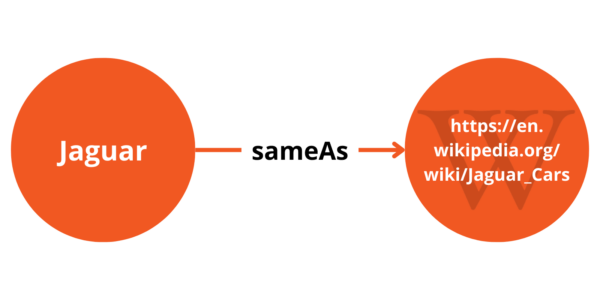Entity linking is the process of identifying entities—unique and distinguishable things or concepts—within your content and connecting them to well-defined corresponding entities on the web. These connections can be made to external authoritative knowledge bases, such as Wikipedia, Wikidata, or Google’s Knowledge Graph, or to an internal Content Knowledge Graph that defines the proprietary entities relevant to your business.
When implemented effectively, entity linking reduces ambiguity and ensures that search engines and AI systems interpret your content in the right context. This improves how your pages are processed, boosts visibility in search, and drives more accurate, high-quality traffic.
In Schema Markup, entity linking explicitly associates your content with the correct external or internal entities. This approach not only disambiguates common terms but also ensures your proprietary product names, services, and people are consistently represented across all your digital content.
Entity linking can be implemented within your Schema Markup using Schema.org properties. In the context of Schema Markup, it often involves “connector” properties, like sameAs, mentions, or about, to connect an entity to a corresponding definition.
For instance, if your page discusses “Jaguar” (the car brand), your JSON-LD markup with entity linking might look like this:
{
"@context": "https://schema.org",
"@type": "Brand",
"name": "Jaguar",
"sameAs": "https://en.wikipedia.org/wiki/Jaguar_Cars",
"sameAs": "https://www.wikidata.org/wiki/Q30055",
"sameAs": "kg:/m/012x34"
}

This explicitly informs search engines that your page refers to the Jaguar car brand—not the animal—removing ambiguity and ensuring the right connections are made.
The Difference Between External and Internal Entity Linking
Entity linking can be approached in two ways, depending on whether you’re connecting to your own proprietary entities or to publicly recognized ones.
What is External Entity Linking?
External entity linking connects the entities in your content to authoritative public knowledge bases, such as Wikipedia, Wikidata, or Google’s Knowledge Graph. This approach is used for widely recognized terms like companies, organizations, or concepts that already have established definitions. By linking to these sources, you disambiguate your content, making it clear which entity you are referencing.
What is Internal Entity Linking?
Internal entity linking is a feature in Schema App’s Entity Hub that connects the entities unique to your organization—such as your products, services, locations, or people—to their authoritative definitions inside your own Content Knowledge Graph. Instead of pointing to external sources like Wikipedia or Wikidata, internal entity linking ensures that references to entities within your content consistently map back to the webpages that best represent them within your own website.
Why is Entity Linking Important?
For enterprises, entity linking is a strategic advantage that enhances content clarity, ensures contextual accuracy, and improves engagement across both human and AI-driven systems.
1. Enhances Search Engine and AI Understanding Through Disambiguation
Branded content often includes specific product names, services, or proprietary terms that might not be universally recognized. These types of entities are best handled with Internal Entity Linking, since they may not exist in external authoritative knowledge bases. By defining these entities within your organization’s Content Knowledge Graph and linking them consistently across your content, you ensure that search engines and AI systems understand them in the correct context.
For widely recognized entities, such as public companies or industry-standard terms, External Entity Linking is more appropriate. Connecting to authoritative knowledge bases like Wikipedia or Wikidata ensures those entities are disambiguated and accurately interpreted.
For example, if your content mentions the term “Apple,” you should use entity linking to clarify if you are referring to the tech brand or the fruit. This prevents confusion and reinforces your content in relevant searches.
This process of disambiguation not only improves search engine accuracy but also supports AI-driven systems that rely on precise context to function effectively. As AI technologies evolve, their ability to understand user intent depends heavily on clear content and structured data.
Entity linking also lays the groundwork for AI systems—such as customer support chatbots or recommendation engines—by ensuring that terms and concepts are consistently tied to the right meanings.
2. Increases Content Discoverability
For enterprises with diverse content, products, or services, content discoverability is crucial for driving traffic and conversions. Entity linking helps search engines connect content to relevant queries more efficiently, making it easier for users to find what they need and click through to pages in search that are closely aligned with their search intent.
At Schema App, we implemented entity linking at scale on our customer Marshfield Clinic Health System’s physician pages. As a result, their pages were ranking for more relevant keywords and saw a 32% increase in click-through rates to those physician pages.
In another experiment, a customer with location-based landing pages implemented place-based entity linking on 11 test pages while leaving 4 pages as controls. The test pages saw a 46% increase in impressions and a 42% increase in clicks for non-branded queries. By clarifying the locations in their Schema Markup, these pages appeared more often for location-based searches such as “near me” queries.
Read Measurable Impact of Scaling Entity Linking for Entity Disambiguation to learn more.
3. Ensures Relevance in a Multilingual and Multiregional Context
Global enterprises targeting audiences across different languages and regions often face challenges with entity ambiguity. Entity linking resolves this by ensuring the correct context is maintained across languages and regions.
For instance, the term “football” might refer to soccer in Europe but American football in the USA. By leveraging entity linking, businesses can disambiguate terms in their content to match the regional context. Linking “football” to FIFA or the NFL ensures that both search engines and users understand whether the content pertains to soccer or American football.
This approach avoids confusion, maintains consistent brand messaging, and ensures the content resonates with the intended audience in each region.
4. Entity Linking Strengthens Your Content Knowledge Graph
External Entity Linking ensures your content aligns with globally recognized entities, while Internal Entity Linking ensures your proprietary knowledge is consistently defined and connected. Both approaches strengthen your Content Knowledge Graph, making your content clearer for search engines, AI systems, and your audience.
“Linking entities to form our organization’s Knowledge Graph is the foundational backbone that must be in place to ensure we’re offering the best care digitally. It allows us to meet our patients in their moment of need, at the start of their health journey. With the right information presented earlier in their search, they can come to us and get care quicker.” – Katie Schneekloth, Lead Digital Marketing Specialist at Marshfield Clinic Health System.
Schema App automates both processes—reducing manual effort, eliminating inconsistencies, and enabling enterprises to scale entity linking effectively.
How We Do Entity Linking at Schema App
At Schema App, we understand the challenges of implementing entity linking manually. Manual approaches often lack scalability, are difficult to maintain, and can lead to outdated or inconsistent data over time.
To address these challenges, we developed Schema App’s Entity Linking Feature, which brings together both internal and external entity linking into one powerful solution.
For External Entity Linking, Schema App uses natural language processing (NLP) to automatically identify entities in your content and link them to authoritative external sources at scale. This removes the need for manual research and reduces the risk of outdated or inconsistent markup since entities will dynamically update with content changes.
For Internal Entity Linking, Schema App enables you to define, manage, and connect the unique entities that matter most to your organization—such as your products, services, people, and locations. By linking these internal entities across your website content, you can unify your brand-specific knowledge and build a consistent, robust Content Knowledge Graph.
Together, internal and external entity linking enable enterprises to strengthen their knowledge graphs, improve content discoverability, and future-proof their SEO strategies.
If you’re ready to implement entity linking at scale and build a comprehensive Content Knowledge Graph for your organization, get in touch with us at Schema App to learn how we can help.

